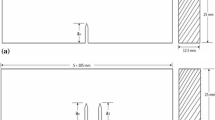Abstract
It is important to perceive the consequences of the presence of cracks or notches on the mechanical properties of the welded component. There are a number of literatures which focus on the fatigue properties of welds. Moreover, the effect of weld parameters on the mechanical properties has been studied by various researchers. However, the work related to the evaluation of tensile properties of welded components and the effect of notch parameters and test parameters on them is relatively scarce. This paper describes an experimental investigation to study the influence of notch root radius and strain rate on the fracture behavior and tensile properties of TIG-welded 6061 aluminum alloy. The tensile tests have been performed on 100 kN Universal Testing Machine under uniaxial static loading. The maximum stress at the notch tip calculated using Neuber’s and Stain Energy Density (SED) methods is compared with the present experimental data. Average percentage variation in the value of maximum stress at the notch tip is 14.5% with respect to Neuber’s and 6.9% with respect to SED method.
Similar content being viewed by others
References
A. Heinz, A. Haszler, C. Keidel, S. Moldenhauer, R. Benedictus, W.S. Miller, Recent development in aluminium alloys for aerospace applications, Material Science and Engineering: A 280 (2000) 102–107.
L.M. Lerner, Hard anodising of aerospace aluminium alloys, Transaction of the Institute of Metal Finishing 88 (2010) 21–24.
S. Das, Development of aluminium alloy composites for Engineering Applications, Transactions of Indian Institute of Metallurgy 57 (2004) 325–334.
M. Geiger, F. Micari, M. Merklein, L. Fratini, D. Contorno, A. Giera, D. Staud, Friction Stir Knead Welding of steel aluminium butt joints, International Journal of Machine Tools and Manufacture 48 (2008) 515–521.
A. Ambroziak, M. Korzeniowski, Using resistance spot welding for joining aluminium elements in automotive industry, Archives of Civil and Mechanical Engineering 10 (2010) 5–13.
P.L. Threadgill, A.J. Leonard, H.R. Shercliff, P.J. Withers, Friction stir welding of aluminium alloys, International Materials Reviews 54 (2009) 49–93.
O.E. Canyurt, Estimation of welded joint strength using genetic algorithm approach, International Journal of Mechanical Sciences 47 (2005) 1249–1261.
M. Imam, K. Biswas, V. Racherla, Effect of weld morphology on mechanical response and failure of friction stir welds in a naturally aged aluminium alloy, Materials and Design 44 (2013) 23–34.
N.T. Nguyen, M.A. Wahab, The effect of undercut and residual stresses on fatigue behaviour of misaligned butt joints, Engineering Fracture Mechanics 55 (1996) 453–469.
W. Cui, Z. Wan, A.E. Mansour, Stress concentration factor in plates with transverse butt-weld misalignment, Journal of Constructional Steel Research 52 (1999) 159–170.
S.V. Pearce, V.M. Linton, E.C. Oliver, Residual stress in a thick section high strength T-butt weld, Material Science and Engineering: A 480 (2008) 411–418.
I. Lillemäe, H. Lammi, L. Molter, H. Remes, Fatigue strength of welded butt joints in thin and slender specimens, International Journal of Fatigue 44 (2012) 98–106.
C. Morgenstern, C.M. Sonsino, A. Hobbacher, F. Sorbo, Fatigue design of aluminium welded joints by the local stress concept with the fictitious notch radius of rf=1 mm, International Journal of Fatigue 28 (2006) 881–890.
A. Ali, M.W. Brown, C.A. Rodopoulos, Modelling of crack coalescence in 2024-T351 Al alloy friction stir welded joints, International Journal of Fatigue 30 (2008) 2030–2043.
R.S. Florea, D.J. Bammann, A. Yeldell, K.N. Solanki, Y. Hammi, Welding parameters influence on fatigue life and micro structure in resistance spot welding of 6061-T6 aluminum alloy, Materials and Design 45 (2013) 456–465.
T. Bruder, K. Störzel, J. Baumgartner, H. Hanselka, Evaluation of nominal and local stress based approaches for the fatigue assessment of seam welds, International Journal of Fatigue 34 (2012) 86–102.
H. Neuber, Theory of stress concentration for shear-strained prismatical bodies with arbitrary nonlinear stress-strain law, Journal of Applied Mechanics 28 (1961) 544–550.
K. Lieb, R. Horstman, B. Power, R. Meltzer, M. Vieth, T. Seeger, P. Heuler, Generalized application of Neuber’s rule, Journal of Testing and Evaluation 8 (1980) 199–204.
K. Molski, G. Glinka, A method of elastic-plastic stress and strain calculation at a notch root, Material Science and Engineering 50 (1981) 93–100.
Author information
Authors and Affiliations
Corresponding author
Rights and permissions
About this article
Cite this article
Singh, R., Chauhan, S. & Gope, P.C. Influence of notch radius and strain rate on the mechanical properties and fracture behavior of TIG-welded 6061 aluminum alloy. Archiv.Civ.Mech.Eng 16, 513–523 (2016). https://doi.org/10.1016/j.acme.2016.01.002
Received:
Accepted:
Published:
Issue Date:
DOI: https://doi.org/10.1016/j.acme.2016.01.002




